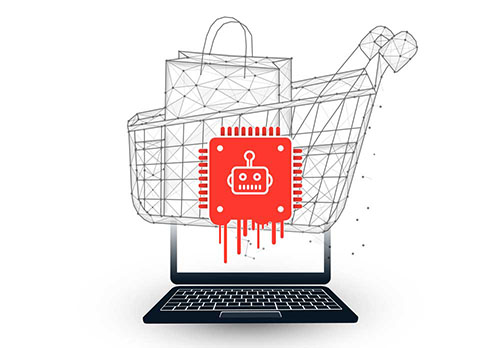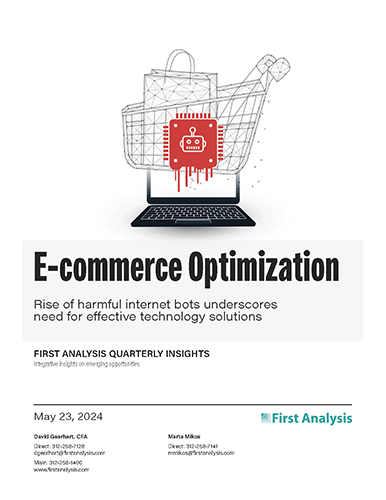Quarterly insights: E-commerce optimization
Rise of harmful internet bots underscores need for effective technology solutions

The pandemic’s acceleration of e-commerce growth has made it more attractive than ever for a shadow industry of ethically compromised entrepreneurs to siphon sales from legitimate e-commerce sites using automated software called scalper bots. Harmful bots altogether, including outrightly criminal bots, represented 32% of all internet traffic as recently as 2023, up from 24% a decade ago.
The damage wrought by scalper and other bots that divert sales from legitimate sites ranges from higher costs and frustration for consumers to lost sales and reputational damage for legitimate sellers.
While many have advocated for legislation and regulation to stop bots, little has come from these efforts. We think companies offering technology solutions to counter bots offer a much more effective and immediate path to minimize the bot threat.
We profile several innovative companies addressing the bot threat in four categories: CAPTCHA, multi-factor authentication, and behavioral analysis technology solutions that help sellers defend against bots and offensive bots that empower consumers.
TABLE OF CONTENTS
Includes discussion of nine private companies
- Rise of the bots
- Multiple types of bad bots active in e-commerce
- A detailed look at scalper bots
- A survey of the damage bots cause
- Coordinated bot efforts exacerbate the threat to businesses
- Botnets also magnify bots’ impact
- Consumers and sellers want a solution (and it’s not regulation)
- Technology is the solution
- Bot-fighting tech offers hope for a better e-commerce future
- Strong one-year gain for e-commerce optimization index, lower growth outlook
- E-commerce M&A: Notable transactions include Squarespace, Cortina and Elevar
- E-commerce private placements: Notable transactions include G2 Reverse Logistics, Scuti, and Krepling
Rise of the bots
Bots, short for internet robots, are computer programs that automate tasks, often standing in for humans and simulating human activities. While they have been deployed in various industries, most people know of bots primarily from their widespread use in e-commerce. Shoppers almost universally view bots negatively, and most have encountered bot activity personally and seen firsthand its impact on website functions, product availability and pricing.
Bot use dates to the advent of online shopping in the mid-90s, but despite bots’ long history, society has yet to effectively counter them. Further, bots’ sophistication and use and the damage they cause have grown dramatically, in large part due to the accelerated growth of e-commerce triggered by the pandemic. As retailers and brands have expedited their online sales strategies, upgrading their websites and online stores and adding online sales channels, a shadow industry of ethically compromised entrepreneurs has burgeoned by using bots to siphon sales and profit from the expanding universe of legitimate sellers. The increasing availability and diversity of items online means no product is immune from being targeted if it’s in demand and profitable.
Bots have gained visibility and notoriety by targeting high-profile goods and services. A prime example was Taylor Swift’s ERA concert tour. It was her first tour in five years after multiple album releases, and the tour announcement ignited unprecedented excitement among fans. It also attracted scalper bots. During the November 2022 pre-sale, Ticketmaster faced overwhelming bot traffic – three times higher than ever before. This forced Ticketmaster to slow and eventually stop sales, leaving many fans empty handed and frustrated. The incident garnered widespread media coverage and a strong backlash.
We think such reports are starting to draw much-needed attention to the bot problem and offering hope it will be effectively addressed near term with advances in technology.

Request full report
To access the full report, please provide your contact information in the form below. Thank you for your interest in First Analysis research.
